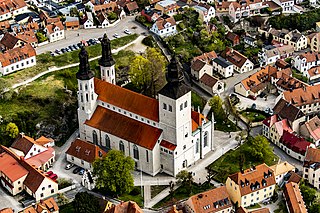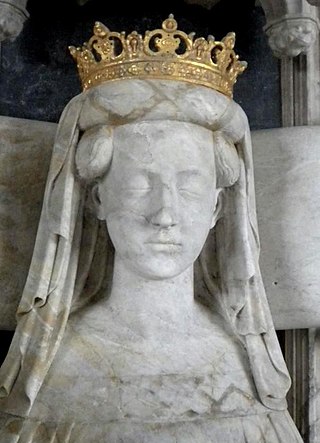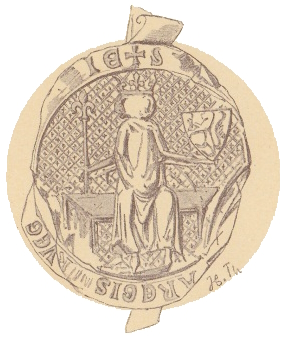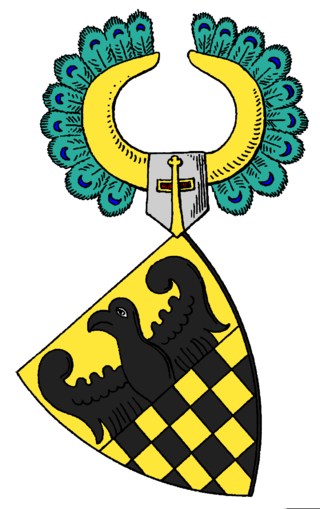
The Hanseatic League was a medieval commercial and defensive confederation of merchant guilds and market towns in Central and Northern Europe. Growing from a few North German towns in the late 12th century, the League expanded between the 13th and 15th centuries and ultimately encompassed nearly 200 settlements across seven modern-day countries, ranging from Estonia in the north and east, to the King's Lynn, England in the west, and Kraków, Poland, in the south.

Visby is an urban area in Sweden and the seat of Gotland Municipality in Gotland County on the island of Gotland with 24,330 inhabitants as of 2017. Visby is also the episcopal see for the Diocese of Visby. The Hanseatic city of Visby is arguably the best-preserved medieval city in Scandinavia, and, since 1995, it has been on the UNESCO World Heritage Site list. Among the most notable historical remains are the 3.4 km (2.1 mi) long town wall that encircles the town center, and a number of church ruins. The decline as a Hanseatic city in the Late Middle Ages was the cause for many stone houses being preserved in their original medieval style.

Margaret I was Queen regnant of Denmark, Norway, and Sweden from the late 1380s until her death, and the founder of the Kalmar Union that joined the Scandinavian kingdoms together for over a century. She had been queen consort of Norway from 1363 to 1380 and of Sweden from 1363 to 1364 by marriage to Haakon VI. Margaret was known as a wise, energetic and capable leader, who governed with "farsighted tact and caution," earning the nickname "Semiramis of the North". She was derisively called "King Breechless", one of several derogatory nicknames invented by her rival Albert of Mecklenburg, but was also known by her subjects as "Lady King", which became widely used in recognition of her capabilities. Knut Gjerset calls her "the first great ruling queen in European history."

The Treaty of Stralsund ended the Danish-Hanseatic War between the Hanseatic League and the kingdom of Denmark. The Hanseatic League reached the peak of its power by the conditions of this treaty.

Magnus IV was King of Sweden from 1319 to 1364, King of Norway as Magnus VII from 1319 to 1355, and ruler of Scania from 1332 to 1360. By adversaries he has been called Magnus Smek.

Haakon VI, also known as Håkan Magnusson, was King of Norway from 1343 until his death and King of Sweden between 1362 and 1364. He is sometimes known as Haakon Magnusson the Younger to distinguish him from his great-grandfather, Haakon V.

Valdemar IV Atterdag, or Waldemar was King of Denmark from 1340 to 1375. He is mostly known for his reunion of Denmark after the bankruptcy and mortgaging of the country to finance wars under previous rulers.

The State of the Teutonic Order was a theocratic state, located along the southeastern shore of the Baltic Sea in northern Europe. It was formed by the knights of the Teutonic Order during the early 13th century Northern Crusades in the region of Prussia. In 1237, the Livonian Brothers of the Sword merged with the Teutonic Order of Prussia and became known as its branch — the Livonian Order. At its greatest territorial extent during the early 15th century, the State encompassed Chełmno Land, Courland, Gotland, Livonia, Estonia, Neumark, Pomerelia, Prussia and Samogitia.
The Skåne Market or Scania market was a major fish market for herring which took place annually in Scania during the Middle Ages. From around 1200, it became one of the most important events for trade around the Baltic Sea and made Scania into a major distribution center for West-European goods bound for eastern Scandinavia. The Scania Market continued to be an important trade center for 250 years and was a cornerstone of the Hanseatic League's wealth.
The Steelyard, from the Middle Low German Stâlhof, was the kontor of the Hanseatic League in London, and their main trading base in England, from the 13th and 16th centuries. The main goods that the League exported from London were wool and from the 14th century woollen cloths. An important import good was beeswax. The kontor tended to be dominated by Rhenish and Westphalian traders, especially from Cologne.

Henning Podebusk or Putbus was a German-Slavic statesman, the last drost of Denmark. He served under King Valdemar IV, King Oluf II, and Queen Margaret I, and he was the de facto ruler of Denmark from 1368 to 1370. Podebusk, whose personal character is unknown, is now considered one of the most important Danish statesmen of the Middle Ages. His political views seem to have been just as cynical and power-centred as that of his royal masters, but perhaps he was an even better diplomat. By his death the office of drost was abolished, probably because he had shown how powerful it might be.

The Battle of Helsingborg was fought on 8 July 1362 between the Danish and Hanseatic fleets during the Danish-Hanseatic War (1361-1370).

The Battle of Visby was fought in 1361 near the town of Visby on the island of Gotland, between the forces of the Danish king and the Gutnish country yeomen. The Danish force was victorious.
Several leagues of cities became influential in the history of the Holy Roman Empire. Military alliance and mutual assistance strengthened the position of imperial cities, especially during the interregnum period of the 13th to 14th century.

The Treaty of Utrecht was signed in 1474 after the Anglo-Hanseatic War between England and the Hanseatic League.
The Hanseatic Days of New Time or the Hansa Days of New Time is an annual international festival of member cities of the Hanseatic League of New Time.

The establishment of a dominium maris baltici was one of the primary political aims of the Danish and Swedish kingdoms in the late medieval and early modern eras. Throughout the Northern Wars the Danish and Swedish navies played a secondary role, as the dominium was contested through control of key coasts by land warfare.

The Dano-Hanseatic War, also known as the Kalmar War with the Hanseatic League, or the Danish-Hanseatic War of 1426-1435, was an armed trade conflict between the Danish-dominated Kalmar Union and the Hanseatic League led by the Free City of Lübeck.
Events from the 14th century in Denmark.
Events from the 1360s in Denmark.














